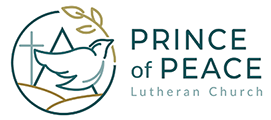Daily Devotions
New devotions are posted Monday, Wednesday, and Friday.
The Rose of Calvary
Today’s author is Prince of Peace member, Scott Tunseth.
This past Sunday the Chancel Choir presented The Rose of Calvary, a cantata by Joseph M. Martin with narration by Pamela Martin. The composer’s intent, in his own words, was to “portray through music the ministry, passion, death, and resurrection of Jesus Christ, the Rose of Sharon.”
But how is Jesus connected to the Rose? The term “rose of Sharon” appears only in the Old Testament’s Song of Songs (Song of Solomon) 2:1: “I am a rose of Sharon, a lily of the valleys.” The speaker is a young woman who compares herself to these wildflowers that bloom on the broad plain of Sharon. Nowhere in the Bible is Jesus ever called the Rose of Sharon or the Rose of Calvary. For that matter. But the connection of Jesus to the rose may have various explanations:
• Jesus is compared with a rose because of its beauty, fragrance, and ability to thrive in harsh conditions. This reflects Christ’s divine nature and his ability to bring hope and salvation to humanity.
• Some interpret the “Rose of Sharon” as representing the church which flourishes under care of Christ, the divine gardener
• Within the context of Song of Songs, the “Rose of Sharon” is seen as a symbol of love and beauty, reflecting the intimate relationship between Christ and his church.
The word Calvary and its connection with Jesus is easier to determine but the term never appears in some Bible versions. Luke 23:33 in the King James Version reads: “And when they came to the place called Calvary, there they crucified him . . .”. In NRSV this verse reads: “When they came to the place called The Skull, they crucified Jesus . . .”. Calvary is from the Latin word Calvariae, which is the place known as The Skull (Golgotha in Aramaic), where Jesus was crucified. But nowhere in the Gospels is Jesus called the Rose of Calvary. The cantata leans on the symbolism of the perfect flower that often grows on a thorny bush. The crown of thorns Jesus wears at his crucifixion is also a reminder of the rose. The beauty of the flower blooms from a thorny stem.
It’s like the theological idea that there is no resurrection without the cross. There is no Easter without Good Friday. There is no new life without death. The apostle Paul says that “the message about the cross is foolishness to those who are perishing, but to us who are being saved it is the power of God” (1 Corinthians 1:18). In his Heidelberg Disputation Martin Luther goes so far as to say, “the person deserves to be called a theologian, however, who understands the ‘back side’ of God (Exod. 33:23) seen through the suffering of the cross” [proof 20].
For Luther, God was hidden or hiding in the suffering of Christ on the cross. But it is precisely there that God works salvation. In the most shocking of places and in the most shameful forms of death. It’s God’s way of turning things upside down. A rose blooms in the desert. A place called The Skull is the entrance to God’s restored garden. The cross is the very power of God at work. Such remarkable grace!
When I survey the wondrous cross on which the Rose of Sharon died,
My richest gain I count but loss and pour contempt on all my pride. Amen
Previously…
Rose
In the tapestry of creation, the rose stands as a resplendent emblem of beauty, intricacy, and profound meaning. Its delicate petals unfurl in a dance of elegance, whispering tales of love, resilience, and grace. As we contemplate the post-resurrection world through the lens of this exquisite bloom, we discover parallels that resonate deeply with the essence of Jesus.
The Rose of Calvary
“I Love the Rose of Calvary, God’s gift of hope, God’s gift of grace.” This is the opening line of the Easter cantata that will be performed on Sunday morning. Written and composed by James Martin, “The Rose of Calvary” tells the story of Jesus’ passion and resurrection, employing the creative imagery of flowers and gardens. Our post-Easter worship series, “Return to the Garden” was inspired by Martin’s creative work.
The Company We Keep
“Be careful of the company you keep.” These may not have been the exact words I heard from my parents as I was growing up, but the message was clear. And I’m sure I passed the same idea on to my sons. Who we choose to associate with can make a profound difference in our lives.
Thistle
In the bustling Greek city of Thessalonica, amidst the tumultuous winds of opposition, Paul and Silas planted the seeds of faith. The Book of Acts and Paul’s first letter to the Thessalonians recounts their journey, marked by fervent preaching and fierce opposition. Like the resilient thistle that thrives in harsh conditions, their mission faced adversity, yet it bore the fruit of perseverance.
